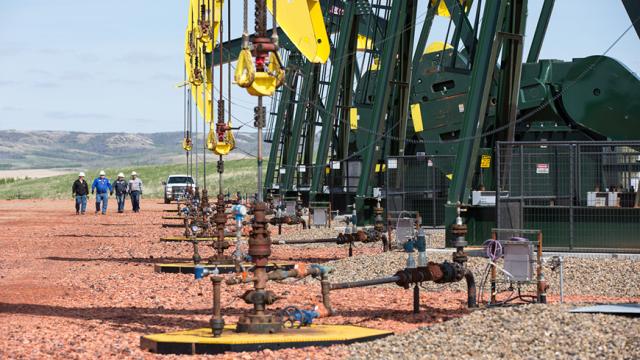
Operations in the U.S. Bakken. CEO John Hess sees his company’s production in the Bakken — and overall U.S. shale production — plateauing from 2024 to 2026. (Source: Hess Corp.)
Hess Corp. CEO John Hess sees his company’s production in the Bakken — and overall U.S. shale production — plateauing from 2024 to 2026.
Bakken production will level out at 200,000 boe/d in 2024 and remain at the rate for eight to 10 years, Hess said during an audio live-streamed fireside chat on Jan. 5 at Goldman Sachs Global Energy & Clean Technology Conference.
Hess’ net Bakken production averaged 166,000 boe/d in third-quarter 2022, according to the company’s website.
Hess said his company had moved up to a four-rig program but will not go to five rigs even at higher oil prices. The four rigs allow Hess Corp. to optimize its infrastructure without having to make incremental investments. Work remains in the midstream sector, but it’s incremental in nature, he said.
“As the world needs more oil and demand grows… shale will be important, but it's no longer the swing producer. I'd say OPEC's back in the driver's seat.” — John Hess, Hess Corp.
“So, running at a four-rig rate, we actually have a 15-year inventory,” Hess said. “Now, we don't want to do M&A to add to it; that 15-year life is... what we see is optimal.”
Looking outside the Bakken and at U.S. shale production in general, he said production would likely plateau in 2025 or 2026 between 13 MMbbl/d and 13.5 MMbbl/d.
“People need to understand, as the world needs more oil and demand grows… shale will be important, but it's no longer the swing producer,” Hess said. “I'd say OPEC's back in the driver's seat.”
New York-based Hess Corp.’s portfolio includes assets in the Bakken and Gulf of Mexico, as well as in Malaysia and Guyana. The company remains focused on advantaged low-cost, low-carbon barrels over the short-to-medium term while maintaining its balance sheet and cash position.
“So, we look at both the Gulf of Mexico and Malaysia as cash engines to complement the cash engine that we have in the Bakken,” Hess said. “And Guyana is not only a cash engine; it's also a growth engine.”
Hess is eyeing capex of $3.7 billion in 2023 compared to $2.7 billion in 2022. At least 80% of 2023 spending will be split between two major assets: Guyana and the Bakken.
Guyana 'growth engine'
Guyana is arguably Hess’ most impressive asset outside the U.S. The company is part of an Exxon-led consortium in the Stabroek Block that also includes CNOOC. Production from the first two offshore developments – Liza Phase I and Liza Phase II – is averaging around 360,000 bbl/d.
“And over time, as more debottlenecking happens, there'll be some upside to that,” Hess said.
Guyana could have six ships or FPSOs operating offshore in Stabroek in 2027 producing an average 1.2 MMbbl/d, Hess said.
The company is moving forward with efforts to drill deeper horizons of Stabroek found at 18,000 ft. Appraisal work is ongoing at Fangtooth, but the company sees potential at deeper horizons than already seen at 15,000 ft.
“We think Fangtooth has the potential, subject to the appraisal that we're drilling one well now and another well later in the year and could potentially be the seventh boat,” Hess said.
RELATED
In 2022, the consortium boasted nine discoveries. Overall, the companies have reported 30 discoveries which are underpinning about 11 Bboe in gross discovered recoverable resources found to date in Stabroek, excluding the 2022 discoveries.
These resources have grown from 1 Bboe to 11 Bboe and multi-billion barrels remain, he said.
Recommended Reading
Carlson: $17B Chesapeake, Southwestern Merger Leaves Midstream Hanging
2024-02-09 - East Daley Analytics expects the $17 billion Chesapeake and Southwestern merger to shift the risk and reward outlook for several midstream services providers.
Turning Down the Volumes: EQT Latest E&P to Retreat from Painful NatGas Prices
2024-03-05 - Despite moves by EQT, Chesapeake and other gassy E&Ps, natural gas prices will likely remain in a funk for at least the next quarter, analysts said.
Midstream Builds in a Bearish Market
2024-03-11 - Midstream companies are sticking to long term plans for an expanded customer base, despite low gas prices, high storage levels and an uncertain political LNG future.
US Natgas Prices Hit 5-week High on Rising Feedgas to Freeport LNG, Output Drop
2024-04-10 - U.S. natural gas futures climbed to a five-week high on April 10 on an increase in feedgas to the Freeport LNG export plant and a drop in output as pipeline maintenance trapped gas in Texas.
Permian NatGas Hits 15-month Low as Negative Prices Linger
2024-04-16 - Prices at the Waha Hub in West Texas closed at negative $2.99/MMBtu on April 15, its lowest since December 2022.




